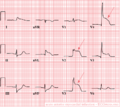Anterior MI: Difference between revisions
Jump to navigation
Jump to search
mNo edit summary |
mNo edit summary |
||
| Line 1: | Line 1: | ||
{{Chapter|Myocardial Infarction}} | {{Chapter|Myocardial Infarction}} | ||
ForceToc_ | |||
ECG-characteristics:<cite>Wung</cite> | ECG-characteristics:<cite>Wung</cite> | ||
ST-elevation in leads V1-V6, I and aVL. Maximum elevation in V3, maximal depression in III | ST-elevation in leads V1-V6, I and aVL. Maximum elevation in V3, maximal depression in III | ||
Revision as of 09:55, 23 July 2007
| This is part of: Myocardial Infarction |
ForceToc_ ECG-characteristics:Wung
ST-elevation in leads V1-V6, I and aVL. Maximum elevation in V3, maximal depression in III later: pathological Q-wave in the precordial leads V2 to V4-V5.


Anterior MI can involve the anterior part of the heart and a part of the ventricular septum. Is supplied by blood by the LAD. Can lead to a cardiac aneurysm if not treated timely.
Examples
-
A typical example of an acute anterior wall infarction. ST elevation in leads I, AVL and V2-V5. Reciprocal depressions in the inferior leads (II,III,AVF)
-
Acute MI with proximal LAD occlusion
-
Large acute MI with LAD occlusion
-
Acute MI with LAD occlusion
-
A 2 weeks old anterior infarction with Q waves in V2-V4 and persisting ST elevation, a sign of formation of a cardiac aneurysm.
References
<biblio>
- Wung pmid=16777513
</biblio>




